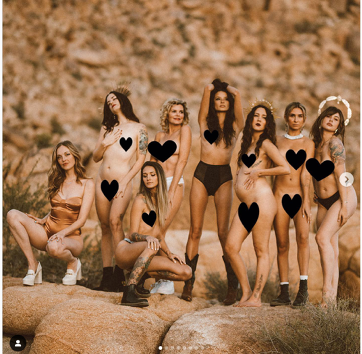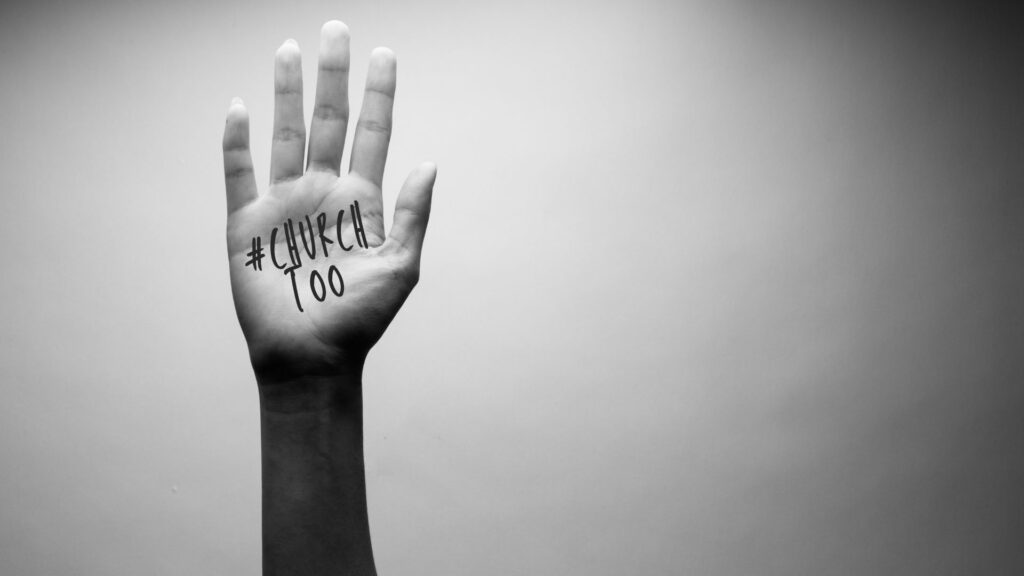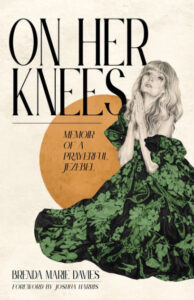White Women's Bodies and the Dilemma of Purity Culture Recovery
Leaders in the “post-purity” movement are promoting sexual liberation and unwittingly reinforcing white supremacy

(Image source: Qieer Wang)
“Purity culture parents, be warned: indoctrinating your daughters may cause religious trauma, … wild self-acceptance & naked frolicking through the desert,” Brenda Davies declared in an Instagram post in the fall of 2021. The host of the popular ex-vangelical podcast, God is Grey, had invited several women to join her in Joshua Tree National Park for a weekend of leisure and celebration. The group of women had all grown up in, but rejected, evangelical purity culture, including three who authored their own memoirs, with a fourth soon to be published.

(Screenshot by article author Sara Moslener of Brenda Davies’ Instagram post. https://www.instagram.com/p/CV5eWLbpEu7/. Image no longer available.)
Beginning in the 1990s, evangelical Christians preached that sexual abstinence until marriage was the most authentic mark of religious piety. It was also, according to its evangelists, the natural prophylactic against future marital strife because it prepared young people to enter marriage without the baggage of sexually transmitted infections or emotional disappointment. Sexual purity campaigns proliferated as millions of adolescents came under their thrall because of the promises offered: relief from heart break, hope for a fairy-tale marriage, and a satisfying sex life.
The women’s weekend in Joshua Tree was a unique group, not simply because they had rejected purity culture, but because many are public figures who use their platforms to decry purity teachings’ misogyny. Sexual purity teaches that women and girls are sexually passive and disinterested in sex, while men and boys are sexually aggressive and over-interested. As others have noted, this permits a rape culture within Christianity—the idea that sexual assault is a natural outgrowth of God-given gender roles.
For the past decade I have been researching people who have rejected evangelical purity teachings. I am also a product of white evangelicalism, and in 2015 I published my first book on the origins of “sexual purity” in the 19th century and its connections to valorizing white womanhood. As I discuss in my book, white Christian women became the symbols of sexual purity and, concurrently, religious piety. But Black women like Sojourner Truth, Fannie Barrier Williams, and Francis Ellen Watkins Harper took issue with white women’s exclusive claim to sexual respectability and called attention to the racism inherent in making white women the models of purity and piety.
With the resurgence of purity ideologies in the late twentieth century, Black women, again, were the first to push back. In 2011, The Crunk Feminist Collective published critiques of purity culture on the CFC blog, including the post, “Single Saved and Sexin’” by gender studies scholar Dr. Brittney Cooper. The post received such backlash that Cooper took two years to return to the topic. A few years later, Cooper’s essay, Grown Woman Theology, describes her experiences as a Black girl who grew up in white evangelicalism in the South. Her commitment to sexual purity was wrapped up in her desire to emulate the white girls whom she perceived as successful and well-respected. A conversation with her grandmother helped her recognize that sexual purity was not a formula for holiness, but white supremacy dressed up as Christian virtue.
By the time Cooper published that essay, white feminists Rachel Held Evans, Sarah Bessey and Elizabeth Esther launched a new conversation among white evangelicals about the inherent gender discrimination in purity teachings. The resistance reached its peak in 2019 with the hashtag #ChurchToo, when artist and activist Emily Joy Allison tweeted about being groomed as a teenager by an adult youth pastor, while simultaneously being taught to value her virginity above all else. Allison’s book #ChurchToo: How Purity Upholds Abuse and How to Find Healing marked a significant shift in opposition to purity culture in that it offered incontrovertible evidence that connected purity culture and sexual abuse in evangelical communities.

(Image source: redletterchristians.org)
The group of women gathered in Joshua Tree in the fall of 2021 represented a fraction of the opposition to purity culture, one reserved for those with public platforms and influencer status. Among the group were podcasters, authors, actors, models, and even a former beauty queen. Despite their proximity to prestige-culture, the memoirs of two of the women present – Brenda Davies and Alice Greczyn – indicate that racial and class privilege do not exempt anyone from internalizing the evangelical teaching that their bodies’ sexual needs and desires are in conflict with godly behavior.
Not all the women present that weekend hold class and race privilege, nor did they all participate in the photo. But the photograph Davies posted, which included herself and Greczyn, reflected a group with access to many privileges, including close proximity to white beauty ideals, suggesting that white women are more likely to experience full recovery from purity culture.
Historian Nell Irvin Painter, author of The History of White People, explains that our contemporary associations with beauty are deeply rooted in colonial histories and the creation of race as an identity category. European scholars who created race, “not only wanted the people they called ‘their women’ to be the most beautiful, and ‘their men’ to be the most virile. They wanted ‘their countries’ to have the best politics. So they wanted to have everything better. And that included beauty.” Origin stories of the racial category “Caucasian” suggest that 17th century biologist Fredrich Blumenbach appropriated the term from people in the Caucasus region because he believed the women there to be the most beautiful. The white beauty ideal is not simply in the eyes of the beholder, but a feature of a white supremacist cultural norms.
 Purity culture teaches that our physical bodies and our need for sexual pleasure cannot be trusted. The body, according to these teachings, leads people to sin. Rejecting those desires offers the assurance of eternal salvation. White women who have disavowed purity culture often report experiences of “disembodiment.” In her memoir, On Her Knees: Memoir of a Prayerful Jezebel, Davies defines disembodiment as “believing the flesh to be evil and the heart deceitful.” For her this meant asking God to save her from her own sexual desires, or to send her a message that having sex was permissible. On her second date with the man she would eventually marry, she heard an answer: his roommate, also a Christian, had just had sex for the first time and had no regrets. At that revelation, Davies was able to relinquish her commitment to sexual purity, because she now believed it impeded her body from embracing the pleasure God had designed for it.
Purity culture teaches that our physical bodies and our need for sexual pleasure cannot be trusted. The body, according to these teachings, leads people to sin. Rejecting those desires offers the assurance of eternal salvation. White women who have disavowed purity culture often report experiences of “disembodiment.” In her memoir, On Her Knees: Memoir of a Prayerful Jezebel, Davies defines disembodiment as “believing the flesh to be evil and the heart deceitful.” For her this meant asking God to save her from her own sexual desires, or to send her a message that having sex was permissible. On her second date with the man she would eventually marry, she heard an answer: his roommate, also a Christian, had just had sex for the first time and had no regrets. At that revelation, Davies was able to relinquish her commitment to sexual purity, because she now believed it impeded her body from embracing the pleasure God had designed for it.
In her own memoir, Wayward: A Memoir of Spiritual Warfare and Sexual Purity, Alice Greczyn describes discovering that her body held the key to her personal happiness. After rejecting Christianity for secular humanism, she found deep meaning in common physical pleasures that had been forbidden in her Christian family and community. She writes that, “I was taught to deny pleasures of the flesh…the physical, material world I was told to fear and abstain from was the very thing that made me want to live. Sex, food, drink, and nature. Music, dance, books, and kisses. Family, friends, animals, cuddles, and the belief-shattering salve of science. These were where I found peace and awe. These were where I found fulfillment and love.”
Like Davies and Greczyn, many in recovery from purity culture seek re-connection with their physical self through mental health therapy, embodiment coaching, and sexual experimentation. However, the dilemma of disembodiment in purity culture is not simply about sexuality. It is also about race.
Those of us raised in white evangelicalism have been socialized into color-blind racism, which allows white and white-passing people to maintain that racial difference and conflict is insignificant. Color-blind racism prioritizes the racial comfort of white people. It allows us to ignore our own racial identities and the long-standing histories of racial violence, which includes the origin of sexual purity.
In the introduction to her memoir, Davies demonstrates a color-blind perspective by asking, “How could I explain that whatever color, creed, sex, sexuality, religion—or lack thereof—you identify with, you might resonate with this book? The reason being, no matter how divided our life experience or ideology, there are universal themes—like fear, shame, and horniness (or the fear and shame that you never get horny)— that help us see one another.”
In seeking to connect across various forms of difference, Davies claims that her experience taps into a universal understanding that can bridge divides. To support her claim she draws upon the words of Dr. Martin Luther King, Jr., writing, “Darkness cannot drive out darkness; only light can do that.” She continues, “When light is shined onto universal human experience—like love, sex, and relationships—we unify, not only with others, but within ourselves. We are meant to be whole.” Her comments dismiss the possibility of racial sexism, that racism impacts all aspects of our lives, including our intimate relationships. By doing so, Davies remains informed by the color-blind racism of her religious upbringing, focusing on unity, peace, and wholeness at the expense of a more accurate understanding of racial conflict. Unwittingly, she is performing another form of disembodiment, one afforded to white people that allows us to ignore our own racial identity and privilege.
Prominent voices, such as Davies and Greszyn, champion a post-purity narrative that prioritizes sexual agency and liberation. But it fails to acknowledge the diverse experiences within that narrative: Black women speaking about the history of resisting sexualized stereotypes, people with disabilities seeking visibility, or asexual people hoping to be taken seriously. All such voices are excluded from a post-purity narrative that takes it cues from second-wave feminism.
Launched in the late 1960s, second wave feminism failed to address the complexities of women’s lived experiences by focusing solely on the needs of straight, white, middle-class women. The voices of queer women and women of color were sequestered as a threat to the movement and feminist victories were marked by the expansion of white women’s successes alone.
In her book, White Women/ Brown Tears: How White Feminism Betrays Women of Color, scholar and journalist, Ruby Hamad shows that the white woman’s dilemma is rooted in the brutal legacy of settler-colonialism. “White society marked the bodies of women of color as a receptacle for its sins so that it may claim innocence for itself, and, as the chosen symbol of the innocent perfection of whiteness, the white damsel with her tears of distress functions as both denial of and absolution for this violence.” She illustrates how in European colonies white women were used to exonerate the entire colonial project as it claimed to bring “civilization” to “barbarous” nations. In the United States, these same strategies became embedded in the project of sexual purity, utilized to justify racial-terror lynchings in the name of protecting innocent white women.
***
A month after Davies posted the group photo from Joshua Tree, she began receiving criticism from some of her followers. They noted that the women’s expression of bodily self-acceptance was achievable because they reflected white beauty ideals. One follower commented that she had been sitting in great discomfort with the photo for similar reasons; it did not reflect a thoughtful engagement with various forms of privilege, nor address the racial segregation that exists within post-purity recovery efforts.
Though the criticisms were offered with support and even celebration of the group’s activities,
Davies defended herself, intimating to her audience that as a mother of a vulnerable child (her toddler was sick at the time) people should extend her grace by minimizing their criticism. She deflected any call to confront the complex issues her followers raised, issues common in spaces where white women and women of color exchange ideas about liberating our bodies.
The ability to shield oneself from painful accountability is a racial habit of white womanhood. Pejoratively, this is referred to as “white women’s tears” because of how frequently people harmed by white women have to console those same women who use their gender-based vulnerability to plead innocence to wrong-doing. Davies’ response reinforced the right of white women to assert their own racial innocence in order to maintain the illusion of moral goodness.
Greczyn on the other hand, was not interested in vulnerability and penned a blog post to vent her frustration. Entitled, “The Photo: How a Girl’s Getaway to Joshua Tree Became a Symbol of White Supremacy and Why I’m Not Here to Do Better,” Greczyn initially articulated the critiques with clarity, “Our photo sent a silent message: You must still be a beautiful, white, and able-bodied woman to represent an ideal of deconstructed purity culture. In this way, our photo symbolized the continued upholding of white Christian supremacy in post-Christian spaces.” She astutely identified why people would object to the picture. Despite this, she went on to claim that while these criticisms were understandable, they were invalid. Greczyn leapt into an attack on “woke culture,” which she believes uses shaming tactics akin to her evangelical upbringing. “We were shamed for being light-skinned. We were shamed for appearing able-bodied. We were shamed for being attractive. We were shamed because I am not curvy, because Brenda is not Black, and because Sophia is not visibly disabled. If we were these, the shame would not have been hurled our way.” She goes on to denounce cancel culture as a secular form of the over-reaching, religious accountability she experienced in her early life. “Know what I think you really hate us for?” she writes, “Beauty privilege.”
She is correct—this is exactly what her critics were saying. Beauty is a racialized construct that exploits women by making us believe that our primary responsibility is to maintain our beauty or seek to achieve this amorphous ideal at all costs. Its power sits at the very nexus of misogyny, white supremacy, and ableism. The problem is not a person or photograph that approximates or achieves this ideal, but an uncritical investment in its meanings.
What is most telling in Greczyn’s post is her brief nod to the issue of race, writing, “I am as Korean as I am French, with so many other ethnicities mingling in my blood that to name them all would be boring. I will write more in the future on the topic of being mixed race and ethnically ambiguous. For now, my personal reckoning with my racial identity is still too fresh to share. Yeah blah yeah, light-skinned privilege and all that, go ahead, school me like I haven’t heard it before.”
Understanding one’s mixed-race identity in the U.S. racial landscape takes much work, especially given the insufficiency of our racial categories. Everyone has the right to pursue their understanding in their own time and way. But Greczyn’s comments belittle the topic altogether, fully rejecting the criticisms of women of color asking her and other members of their group to consider the overall impact of the photos’ racial representation. Though she raises thoughtful questions in the midst of her anger, Greczyn displays a form of racial fragility that is especially manifest among white and white-passing women who struggle to understand what it means to hold multiple social identities, some that confer privilege and others that designate vulnerability.
***
Sexual purity holds a racist legacy that many white women raised in evangelical purity culture were never taught to acknowledge. In our color-blind, white churches we learned to be obedient and demure, always deferring to people in power.
Today, some former evangelicals engage in robust conversations about the failure of white evangelicalism to address racism and how our experiences have been shaped by racial privilege and white supremacy. From this viewpoint, we see how sexual liberation is only one thread in a tapestry of collective freedom that must include an examination of how white supremacy informs our claims to sexual healing. Exploring how we, as survivors of sexual and religious trauma, remain tied to systems of privilege and oppression allows us to find healing from our own racist habits. More importantly, it allows us to see how whiteness intercepts our desires for clarity and compassion, distorting them into hardened ideologies and white-saviorism.
Rejection of and recovery from purity culture requires us to engage with intersecting forms of privilege and oppression. For white and white-passing women, this means understanding that efforts to achieve idealized versions of ourselves are not just projects in self-enhancement, but in maintaining the white racial privilege we have been trained to ignore. Being able to experience sexual pleasure after years of sex-negative indoctrination can be an act of resistance. But acts of personal resistance do not address purity culture’s collective harms. While leaving evangelicalism and purity culture may offer white women opportunities for achieving personal and sexual fulfillment, that does not equate to sexual, gender, or racial justice.
The critics of the Joshua Tree photo have taught us something important. The dilemma of white womanhood that we have inherited is the inability to see beyond our own well-being. Recovery from purity culture and its supporting ideologies is a multi-faceted project that requires attention to the historical and religious formation of our sexual and racial embodiment.
Sara Moslener is a Lecturer in the Department of Philosophy, Anthropology, and Religion at Central Michigan University. She is currently writing her second book on evangelical purity culture focusing on the racial formation of white womanhood.